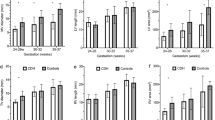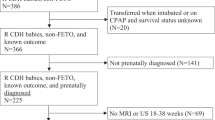Abstract
Objective:
To seek a simple approach for prenatally classifying congenital diaphragmatic hernia (CDH) severity using fetal magnetic resonance imaging (MRI) markers.
Study design:
A retrospective, multicenter study using questionnaires to investigate fetal MRI findings. We included fetuses prenatally diagnosed with isolated left-sided CDH and delivered after 36 weeks of gestation. We focused on three fetal MRI morphological signs: incomplete pulmonary baseline (IPB), liver up (LU) and retrocardiac stomach (RCS). We also evaluated the fetal MRI score defined as the total number of positive signs; the primary outcome was survival at discharge.
Results:
In 256 patients (from 56 institutions), IPB, LU and RCS findings correlated with lower survival: odds ratio (95% confidence interval), 0.16 (0.08 to 0.33); 0.24 (0.12 to 0.51); and 0.14 (0.07 to 0.28); respectively. Patients with higher fetal MRI scores had a higher mortality rate.
Conclusion:
IPB, LU and RCS on fetal MRI are related to CDH severity.
This is a preview of subscription content, access via your institution
Access options
Subscribe to this journal
Receive 12 print issues and online access
$259.00 per year
only $21.58 per issue
Buy this article
- Purchase on Springer Link
- Instant access to full article PDF
Prices may be subject to local taxes which are calculated during checkout


Similar content being viewed by others
References
Stege G, Fenton A, Jaffray B . Nihilism in the 1990 s: the true mortality of congenital diaphragmatic hernia. Pediatrics 2003; 112 (3 Pt 1): 532–535.
Hedrick HL . Management of prenatally diagnosed congenital diaphragmatichernia. Semin Pediatr Surg 2013; 22 (1): 37–43.
Dott MM, Wong LY, Rasmussen SA . Population-based study of congenital diaphragmatic hernia: risk factors and survival in Metropolitan Atlanta, 1968-1999. Birth Defects Res A Clin Mol Teratol 2003; 67 (4): 261–267.
Levison J, Halliday R, Holland AJ, Walker K, Williams G, Shi E et al. A population-based study of congenital diaphragmatic hernia outcome in New South Wales and the Australian Capital Territory, Australia, 1992-2001. J Pediatr Surg 2006; 41 (6): 1049–1053.
Cannon C, Dildy GA, Ward R, Varner MW, Dudley DJ . A population-based study of congenital diaphragmatic hernia in Utah: 1988-1994. Obstet Gynecol 1996; 87 (6): 959–963.
Molenaar JC, Bos AP, Hazebroek FW, Tibboel D . Congenital diaphragmatic hernia, what defect? J Pediatr Surg 1991; 26 (3): 248–254.
Hayakawa M, Seo T, Itakua A, Hayashi S, Miyauchi M, Sato Y et al. The MRI findings of the right-sided fetal lung can be used to predict postnatal mortality and the requirement for extracorporeal membrane oxygenation in isolated left-sided congenital diaphragmatic hernia. Pediatr Res 2007; 62 (1): 93–97.
Hubbard AM, Crombleholme TM, Adzick NS, Coleman BG, Howell LJ, Meyer JS et al. Prenatal MRI evaluation of congenital diaphragmatic hernia. Am J Perinatol 1999; 16 (8): 407–413.
Jani J, Cannie M, Sonigo P, Robert Y, Moreno O, Benachi A et al. Value of prenatal magnetic resonance imaging in the prediction of postnatal outcome in fetuses with diaphragmatic hernia. Ultrasound Obstet Gynecol 2008; 32 (6): 793–799.
Cannie M, Jani JC, De Keyzer F, Devlieger R, Van Schoubroeck D, Witters I et al. Fetal body volume: use at MR imaging to quantify relative lung volume in fetuses suspected of having pulmonary hypoplasia. Radiology 2006; 241 (3): 847–853.
Gorincour G, Bouvenot J, Mourot MG, Sonigo P, Chaumoitre K, Garel C et al. Prenatal prognosis of congenital diaphragmatic hernia using magnetic resonance imaging measurement of fetal lung volume. Ultrasound Obstet Gynecol 2005; 26 (7): 738–744.
Walsh DS, Hubbard AM, Olutoye OO, Howell LJ, Crombleholme TM, Flake AW et al. Assessment of fetal lung volumes and liver herniation with magnetic resonance imaging in congenital diaphragmatic hernia. Am J Obstet Gynecol 2000; 183 (5): 1067–1069.
Nagata K, Usui N, Kanamori Y, Takahashi S, Hayakawa M, Okuyama H et al. The current profile and outcome of congenital diaphragmatic hernia: a nationwide survey in Japan. J Pediatr Surg 2013; 48 (4): 738–744.
O'Mahony E, Stewart M, Sampson A, East C, Palma-Dias R . Perinatal outcome of congenital diaphragmatic hernia in an Australian tertiary hospital. Aust N Z J Obstet Gynaecol 2011; 52 (2): 189–194.
Kitano Y, Okuyama H, Saito M, Usui N, Morikawa N, Masumoto K et al. Re-evaluation of stomach position as a simple prognostic factor in fetal left congenital diaphragmatic hernia: a multicenter survey in Japan. Ultrasound Obstet Gynecol 2011; 37 (3): 277–282.
Hasegawa T, Kamata S, Imura K, Ishikawa S, Okuyama H, Okada A et al. Use of lung-thorax transverse area ratio in the antenatal evaluation of lung hypoplasia in congenital diaphragmatic hernia. J Clin Ultrasound 1990; 18 (9): 705–709.
Lipshutz GS, Albanese CT, Feldstein VA, Jennings RW, Housley HT, Beech R et al. Prospective analysis of lung-to-head ratio predicts survival for patients with prenatally diagnosed congenital diaphragmatic hernia. J Pediatr Surg 1997; 32 (11): 1634–1636.
Laudy JA, Van Gucht M, Van Dooren MF, Wladimiroff JW, Tibboel D . Congenital diaphragmatic hernia: an evaluation of the prognostic value of the lung-to-head ratio and other prenatal parameters. Prenat Diagn 2003; 23 (8): 634–639.
Usui N, Kitano Y, Okuyama H, Saito M, Morikawa N, Takayasu H et al. Reliability of the lung to thorax transverse area ratio as a predictive parameter in fetuses with congenital diaphragmatic hernia. Pediatr Surg Int 2011; 27 (1): 39–45.
Lewis DA, Reickert C, Bowerman R, Hirschl RB . Prenatal ultrasonography frequently fails to diagnose congenital diaphragmatic hernia. J Pediatr Surg 1997; 32 (2): 352–356.
Kilian AK, Schaible T, Hofmann V, Brade J, Neff KW, Busing KA . Congenital diaphragmatic hernia: predictive value of MRI relative lung-to-head ratio compared with MRI fetal lung volume and sonographic lung-to-head ratio. AJR Am J Roentgenol 2009; 192 (1): 153–158.
Tanigaki S, Miyakoshi K, Tanaka M, Hattori Y, Matsumoto T, Ueno K et al. Pulmonary hypoplasia: prediction with use of ratio of MR imaging-measured fetal lung volume to US-estimated fetal body weight. Radiology 2004; 232 (3): 767–772.
Matsushita M, Ishii K, Tamura M, Takahashi Y, Kamura T, Takakuwa K et al. Perinatal magnetic resonance fetal lung volumetry and fetal lung-to-liver signal intensity ratio for predicting short outcome in isolated congenital diaphragmatic hernia and cystic adenomatoid malformation of the lung. J Obstet Gynaecol Res 2008; 34 (2): 162–167.
Mahieu-Caputo D, Sonigo P, Dommergues M, Fournet JC, Thalabard JC, Abarca C et al. Fetal lung volume measurement by magnetic resonance imaging in congenital diaphragmatic hernia. BJOG 2001; 108 (8): 863–868.
Metkus AP, Filly RA, Stringer MD, Harrison MR, Adzick NS . Sonographic predictors of survival in fetal diaphragmatic hernia. J Pediatr Surg 1996; 31 (1): 148–151: discussion 151–142.
Albanese CT, Lopoo J, Goldstein RB, Filly RA, Feldstein VA, Calen PW et al. Fetal liver position and perinatal outcome for congenital diaphragmatic hernia. Prenat Diagn 1998; 18 (11): 1138–1142.
Hayakawa M, Ito M, Hattori T, Kanamori Y, Okuyama H, Inamura N et al. The effect of hospital volume on the mortality of congenital diaphragmatic hernia in Japan. Pediatr Int 2013; 55 (2): 190–196.
Acknowledgements
We thank the persons in charge of the participating institutions for responding to our research.
Author information
Authors and Affiliations
Corresponding author
Ethics declarations
Competing interests
Tetsuo Hattori wrote the first draft of the manuscript. The remaining authors declare no conflict of interest.
Rights and permissions
About this article
Cite this article
Hattori, T., Hayakawa, M., Ito, M. et al. The relationship between three signs of fetal magnetic resonance imaging and severity of congenital diaphragmatic hernia. J Perinatol 37, 265–269 (2017). https://doi.org/10.1038/jp.2016.208
Received:
Revised:
Accepted:
Published:
Issue Date:
DOI: https://doi.org/10.1038/jp.2016.208
This article is cited by
-
Prenatal predictors of mortality in fetuses with congenital diaphragmatic hernia: a systematic review and meta-analysis
Pediatric Surgery International (2022)



